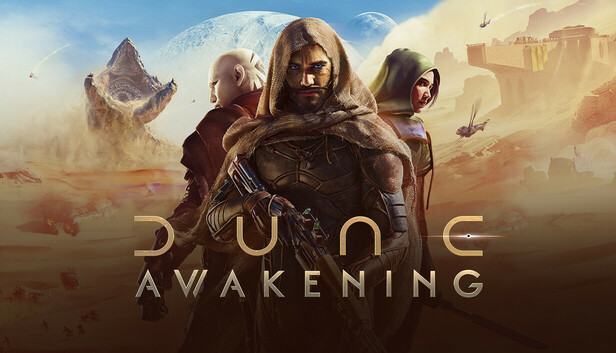The Spice Must Flow: Dune: Awakening After 100 Hours and the Great Endgame Reckoning
Introduction: The Sleeper Has Awakened
The launch of Dune: Awakening on June 10, 2025, was less a release and more a planetary event. Developer Funcom, known for its work on persistent online worlds like Conan Exiles, unleashed a commercial behemoth upon the gaming landscape. The game shattered studio records, becoming Funcom’s fastest-selling title with one million copies sold shortly after its debut. At its zenith, the sands of Arrakis hosted over 189,000 concurrent players on Steam alone, a testament to the immense gravitational pull of Frank Herbert’s universe. This initial surge of enthusiasm was mirrored in its critical reception, quickly earning a “Very Positive” aggregate rating from tens of thousands of players.
As players delve into the universe of Dune: Awakening, they will find themselves encountering unique challenges and experiences that define the essence of Dune Awakening. This game isn’t just a title; it’s a chance to live out the harsh realities of Arrakis.
The immersive world of Dune Awakening truly shines as players adapt to the environment. Each hour spent in Dune Awakening reveals more of its depth, making it a landmark title for fans of the genre.
However, as with any massively multiplayer online (MMO) experience, the true measure of a world is not found in its opening days but in the long hours after the initial novelty fades. This analysis moves beyond the “honeymoon phase” of discovery to investigate the game’s deeper substance. What is the true nature of life on Arrakis after 100 hours of survival, crafting, and conflict? More importantly, how has a turbulent and divisive endgame experience—and Funcom’s subsequent, decisive response—shaped the game’s identity and defined its future? The story of
Dune: Awakening is a journey from a universally praised survival simulation to a high-stakes political battlefield, a tale of a game finding its soul amidst the shifting sands.
Part I: The Golden Path – The First 100 Hours on Arrakis
Dune Awakening: The Challenges Ahead
The initial player experience in Dune: Awakening is almost universally lauded. Before the complexities of endgame politics and PvP conflict emerge, the game presents a masterfully crafted survival adventure that captivates players and immerses them completely in the brutal beauty of Arrakis.
In Dune Awakening, survival hinges on understanding the intricate systems at play, as players navigate the threats of Arrakis and its unforgiving landscape.
This is where Dune Awakening excels, blending lore and gameplay seamlessly. The lessons learned in this universe can guide players toward mastery.
The thrill of encountering mythic creatures, like the sandworm, is heightened when players understand the lore behind them from Dune Awakening.
Surviving the Sun and Sand: A Masterclass in Atmosphere
The game’s greatest early achievement is how it subverts the conventions of the survival genre by rooting its mechanics in the source material. Where other games present generic hunger and thirst meters, Dune: Awakening centers its entire survival loop on the quintessentially Fremen concept of “water discipline”. From the very beginning, players are taught the harsh lessons of the desert: seek the shadows to avoid the scorching sun, craft stillsuits to recycle precious moisture, and, in moments of desperation, extract water from the bodies of fallen enemies. This is not merely a background system; it is an active and engaging struggle against the planet itself, making the environment the primary antagonist.
This harsh introduction is managed by an extensive and well-integrated tutorial system. Over a period that can last up to ten hours for new players, the game carefully guides them through its deep systems, weaving lessons on crafting, base building, and hydration into the main story missions. This approach prevents the initial experience from becoming overwhelming and ensures that both genre veterans and newcomers can find their footing on the treacherous sands.
This struggle is punctuated by moments of genuine awe and terror. Player testimonials frequently highlight the adrenaline-fueled experience of fleeing a colossal sandworm (Shai-Hulud) on a fragile sandbike for the first time. The world is made even more unpredictable by the arrival of lethal Coriolis storms, which periodically sweep across the landscape, reshaping the dunes and turning familiar territory into a deadly, unknown expanse. These elements combine to make the player feel “fragile, weak, and desperate,” a state that, in the context of Dune, is not a flaw but a core feature of its immersive power.
A World Worth Exploring: Traversal and Discovery
Exploring the vast, open world of Arrakis is a consistent high point for players. This is largely due to a traversal system that makes movement a joy rather than a chore. Players can glide across canyons with suspensor belts, scale sheer cliffs with grappling hooks, and climb virtually any surface, granting an unparalleled sense of freedom.
Those who explore the depths of Dune Awakening will discover a world rich with challenges and rewards, keeping them engaged for countless hours.
The intricate crafting system in Dune Awakening encourages players to think strategically about their choices in this vast universe.
As players delve deeper into Dune Awakening, they will find their strategies evolving, enhancing their gameplay experience on Arrakis.
This experience is elevated to new heights with the crafting of a player’s first Ornithopter. This moment is frequently cited as a pivotal and exhilarating milestone, transforming the player from a ground-bound survivor into a master of the skies. Soaring above the beautifully rendered landscapes, built in Unreal Engine 5, represents a tangible reward for hours of effort and a fundamental shift in the player’s relationship with the world.
However, the journey through Dune Awakening isn’t without its challenges, particularly as players transition into the endgame.
This exploration is set against a compelling narrative backdrop. The game takes place in an alternate history where Paul Atreides was never born, and Duke Leto Atreides survived the Harkonnen assault on Arrakeen. This clever premise gives Funcom the creative freedom to tell a new story centered on the mysterious disappearance of the Fremen, while still leveraging the rich lore and familiar factions of the universe. This approach has been praised for its originality and its deep respect for the source material, offering a fresh yet authentic Dune experience. The game’s success in this area stems from a core design philosophy: the mechanics are not merely placed within the world of Dune; they are born from it. The harshness of the planet necessitates the water discipline system, its vast scale demands Ornithopters for travel, and its political intrigue gives rise to the faction and Landsraad mechanics. This deep integration ensures that the act of playing the game
The combat in Dune Awakening needs to feel more rewarding, particularly for those who thrive on adrenaline during their adventures.
While Dune Awakening has its flaws, its world remains captivating, encouraging players to strive for improvement and mastery.
The game’s evolution mirrors the challenges faced by players, much like the shifting sands depicted in Dune Awakening.
is the Dune experience, creating a powerful and memorable first impression.
Understanding the meta in Dune Awakening can significantly enhance player strategy and enjoyment.
As the developers work to refine Dune Awakening, players can look forward to a more balanced experience.
Building Your Empire: The Satisfying Mid-Game Loop
The grind in Dune Awakening remains a point of contention, but it serves as a test of perseverance for players.
As players establish themselves, the game transitions into a deeply satisfying loop of crafting, building, and research. The building system is both robust and flexible, allowing for the construction of everything from a simple shelter to an impenetrable fortress. A key feature is the ability to save base designs as blueprints, which can then be sold to other players on a server-wide Exchange, fostering a dynamic and player-driven economy.
Future updates promise to enhance the Dune Awakening experience, making it even more engaging for players.
As challenges arise, players will find themselves drawn back into the world of Dune Awakening, eager to adapt and overcome.
The evolving landscape of Dune Awakening reflects the dynamic nature of player interactions and experiences.
Progression is not tied to a simple experience bar but to a unique research system based on “Intel” points. Players acquire Intel by exploring, completing quests, and engaging in combat, then spend these points to unlock new technologies and crafting recipes in extensive research trees. This system encourages active engagement with all facets of the game and allows for both individual specialization and coordinated technological advancement within guilds.
For the first 80 to 100 hours, this progression loop is described as “incredibly well paced,” with minimal filler or tedious grinding. While some activities, like raiding NPC camps for specific components or harvesting blood for water, are repetitive, many players find them to be part of an enjoyable and “meditative” routine that reinforces the fantasy of carving out a life on an inhospitable world.
Players willing to embrace the challenges of Dune Awakening will find a rewarding journey ahead.
Part II: The 100-Hour Wall – Cracks in the Empire
For all its early-game brilliance, many players find that the experience begins to sour as they push past the 100-hour mark and approach the endgame. The satisfying survival adventure gives way to a different, more contentious experience, where long-simmering mechanical flaws and a jarring shift in design philosophy come to the forefront.
The Unfulfilling Blade: A Combat System Under Fire
One of the most consistent criticisms leveled against Dune: Awakening, from both professional reviews and player feedback, is its combat system. It is frequently described as “awful,” “janky,” “weightless,” and “repetitive”. The problems are systemic. Ranged combat, while present, is often rendered ineffective by the prevalence of Holtzman shields on most formidable enemies, which deflect projectile attacks. This forces players into melee, which itself lacks depth and impact. Most melee encounters devolve into monotonous and identical attack patterns, a problem exacerbated by technical issues like unresponsive parry commands.
This mechanical weakness is compounded by a shallow combat progression system. Players have a limited number of active skill slots, with one often being occupied by the near-essential grappling hook. The passive talents available largely offer minor, incremental stat bumps, leading to a sense that characters never grow in a meaningful way or develop distinct combat identities. While these issues are tolerable during the PvE-focused survival phase, they become a significant source of frustration in the PvP-centric endgame.
The Endgame Conundrum: The Deep Desert at Launch
The game’s initial endgame design was the primary source of player backlash. The main endgame zone, the Deep Desert, was a mandatory, free-for-all PvP area where players were automatically flagged for combat. This design choice, which stood in stark contrast to the game’s marketing of “optional PvP,” created what many players described as a “toxic” environment dominated by griefing.
Ultimately, Dune Awakening encapsulates the essence of survival, offering players an unparalleled adventure.
The meta that emerged was particularly frustrating. The dominant strategy involved players using fast, agile Scout Ornithopters armed with rockets to “carpet bomb” other players and resource nodes from the relative safety of the air. This made ground-based activities, including the crucial harvesting of endgame resources, nearly impossible for those not participating in this aerial warfare. Furthermore, the supremacy of the armed Scout Ornithopter rendered most other vehicles in the game obsolete.
This environment created a hard wall for solo players and smaller, PvE-focused guilds. Essential endgame crafting materials like Titanium, Stravidium, and Plasteel were located exclusively within this hyper-competitive PvP zone, effectively gatekeeping progression for a large portion of the player base. The game that had begun as an engrossing survival adventure for everyone abruptly became an exclusionary territory-control MMO. This fundamental shift in the game’s nature, from a personal journey of survival to a communal war for dominance, was at the heart of the community’s frustration.
The Grind and the Shallow End
For those who pushed through the PvP challenges, the endgame loop itself was often found wanting. Once the main story quests concluded, gameplay devolved into monotonous activities, such as repeatedly raiding the same points of interest for small quantities of rare materials or exploring a vast but largely empty, procedurally generated Deep Desert map.
Many players, particularly those playing solo, reported a profound lack of payoff. After an incredible journey of over 100 hours, they arrived at a destination with no new story developments, no challenging dungeons, and no meaningful rewards—only a perpetual grind for better numbers in a hostile zone that demanded a group for survival. This was compounded by a design choice that forced players into a nomadic lifestyle, requiring them to constantly relocate their main base to be closer to higher-tier resources, a mechanic that directly conflicted with the deep-seated survival game fantasy of building a permanent, elaborate home.
Part III: The Shifting Sands – How Funcom is Reshaping Arrakis
Faced with significant player backlash regarding a flawed endgame, Funcom’s response was swift and decisive. Rather than making minor tweaks, the developers engaged directly with the community and implemented fundamental changes that have reshaped the experience on Arrakis, demonstrating a commitment to the game’s long-term health.
The Great Divide: Rebalancing the Deep Desert
The centerpiece of Funcom’s post-launch strategy was a direct acknowledgment of the problems plaguing the endgame. In a message from the Creative Director, the team addressed the community’s feedback on the “toxic” PvP experience and laid out a plan for change. This communication set the stage for Patch 1.1.0.17, a landmark update that fundamentally altered the Deep Desert.
The single most impactful change was the division of the zone into two distinct halves: the southern portion became a dedicated PvE area, while the northern portion remained a high-stakes PvP battleground. The goal was not to eliminate conflict but to rebalance the “Risk vs. Reward” dynamic. The patch ensured that all essential endgame resources could now be found within the safer PvE zone. However, to incentivize conflict, the highest density of these resources, the largest spice blows, and the most valuable loot remained concentrated in the northern PvP territory.
This rebalance was supported by an overhaul of the loot system. In the PvE zone, rewards from points of interest became instanced, with each player receiving their own guaranteed loot (e.g., one schematic per player). In the PvP zone, the system remained a competitive “first come, first served” model, but with significantly increased rewards (e.g., two to six schematics, with a higher chance for rare variants). This elegant solution gave players a genuine choice: engage in safer, slower progression in the PvE zone, or venture into the dangerous north for a chance at greater, more immediate rewards.
Key Table: The Evolution of the Deep Desert
The following table summarizes the critical changes made to the Deep Desert, illustrating the direct response to the primary issues players faced at launch.
| Feature | State at Launch (Pre-Patch 1.1.0.17) | Current State (Post-Patch 1.1.0.17) |
| Zone Layout | Entire Deep Desert is a forced-flag, free-for-all PvP zone. | Southern half is designated PvE; Northern half remains PvP. |
| Endgame Resources | All high-tier resources (e.g., Titanium, Plasteel) are exclusively located in the PvP zone, gating progression. | All resources are now available in the PvE zone. High-density clusters and Plasteel Plates are concentrated in the PvP zone as a high-risk reward. |
| Loot from POIs | First-come, first-served loot for all activities, leading to conflict and frustration for non-PvP players. | PvE zone features instanced, per-player loot. PvP zone remains first-come, first-served but with significantly higher rewards. |
| Player Choice | Players interested in endgame progression are forced to participate in PvP. | Players have a meaningful choice between safer, slower PvE progression and high-risk, high-reward PvP progression. |
| Solo Viability | Extremely difficult and frustrating for solo players to progress. | Solo players can now fully progress through the endgame crafting tiers by staying within the PvE zone. |
Grounding the Fleet: Nerfing the Ornithopter Meta
Alongside the zone redesign, Funcom took direct aim at the dominant vehicle meta. An early hotfix removed the ability for vehicles to inflict collision damage on players, ending the tactic of simply squishing opponents. More significantly, Patch 1.1.0.17 introduced a crucial trade-off for armed Ornithopters. Equipping a rocket launcher module now reduces the top speed of a Scout Ornithopter by 20% and an Assault Ornithopter by 10%. This forces players to choose between combat power and maneuverability, effectively breaking the “do-it-all” supremacy of the armed Scout and adding tactical depth to vehicle loadouts.
Quality of Life and the Road Ahead
These major changes have been accompanied by a steady stream of quality-of-life improvements, including stability fixes, the introduction of a player reporting system, and the removal of restrictions on claiming land in different sietches to foster a more unified world. Looking forward, developers have stated they plan to evolve PvE content with dungeons and boss encounters while also working to make PvP more rewarding. This pattern of launching with issues but responding with decisive, community-informed fixes is characteristic of a modern live service game, suggesting a long-term commitment to refining and expanding the world of Arrakis.
Conclusion: Is the Spice Still Worth the Fight?
The journey through Dune: Awakening is a tale of two distinct games. The first is a brilliant and deeply immersive survival adventure that stands as one of the best in its class. The second is a complex, high-stakes MMO endgame that, while critically flawed at launch, has undergone a significant and successful revision in response to player feedback. The game’s greatest weakness—a jarring identity crisis at the transition to its endgame—has been directly addressed by a development team that has proven it is listening.
The result is a game that can now be recommended, albeit with caveats, to a wider range of players.
- For the Solo and Co-op Explorer: The first 100 hours are an unequivocal triumph of atmosphere and design, worth the price of admission alone. With the redesign of the Deep Desert, a viable, albeit slower, solo endgame path now exists, allowing these players to experience the full breadth of the game’s content without being forced into unwanted conflict.
- For the PvP Warlord and Guild Member: The endgame offers a complex and rewarding loop of political maneuvering, resource control, and large-scale warfare. The rebalance has focused the conflict into a more purposeful high-risk, high-reward zone, making strategic combat more meaningful than the chaotic free-for-all of the launch window.
- For the Player Who Demands Polished Combat: The combat system remains the game’s most significant unresolved issue. It is functional but lacks the weight, depth, and polish expected of a modern MMO. Players for whom fluid, satisfying combat is a top priority should remain wary, as this is the one area yet to receive a major overhaul.
Ultimately, Dune: Awakening is an ambitious, beautiful, and deeply flawed masterpiece-in-progress. Its greatest asset is not only its stunningly faithful recreation of Arrakis but also a development team that has turned a potential launch disaster into a demonstration of its long-term commitment. The spice is potent, and for those willing to brave the game’s remaining rough edges, the fight to control its flow is a compelling one.












Add comment